Inventions
Pause Pod
It's a personal-sized tent that you can bust out at work when you need "Your Private Space for Relaxation." Or use it at home to "Evoke Mindfulness."Available for $99 via indiegogo.


Posted By: Alex - Sun Oct 01, 2017 -
Comments (5)
Category: Inventions
The Morale Raiser
Also known as a pat-on-the-back machine. An earlier version of this.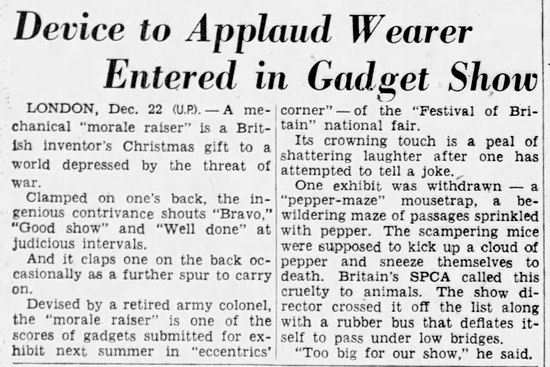
Wilmington News Journal - Dec 22, 1950
Posted By: Alex - Sun Sep 17, 2017 -
Comments (3)
Category: Inventions, 1950s
Drip Fire Rifle
Invented by Lance Corporal William Charles Scurry during WWI, while fighting in Gallipoli. The Drip Fire Rifle was a way to jerry-rig a rifle using readily available materials so that it would randomly fire on its own. The Australian forces set up a whole bunch of these Drip Fire Rifles, and in this way were able to fool the Turkish forces into thinking they were actively manning the front lines, when in fact they were all sneaking away in boats. From abc.net.au: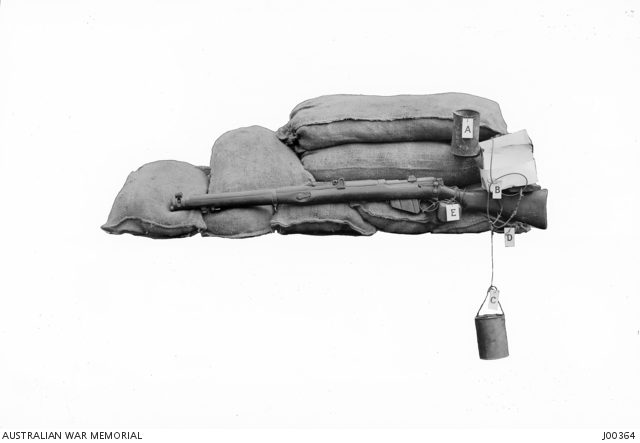
Posted By: Alex - Sat Sep 16, 2017 -
Comments (1)
Category: Inventions, War, Weapons, 1910s
Wasabi Smoke Alarm
Fire alarms for the deaf typically involve strobe lights or vibration (such as a vibrating bed or pillow to wake a sleeper). But over in Japan, a few years back, researchers invented an alarm that sprayed the smell of Wasabi into the air. Tests revealed it could wake sleepers within two minutes.The researchers also tested the smells of banana, coconut milk, and tea tree oil, but they found the smell of wasabi worked best.
More info: BBC News
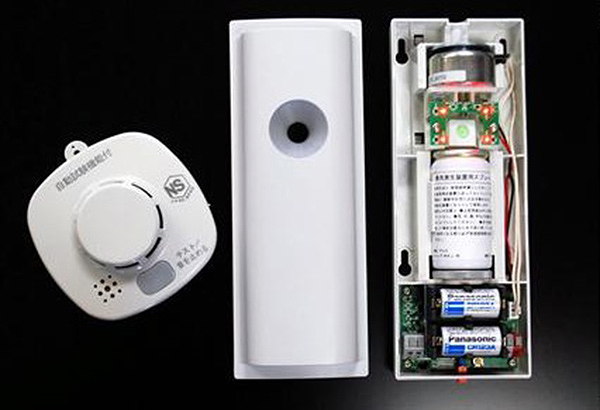
Posted By: Alex - Fri Sep 15, 2017 -
Comments (1)
Category: Inventions
Len Solomon and the Bellowphone
Posted By: Paul - Mon Aug 21, 2017 -
Comments (0)
Category: Eccentrics, Inventions, Music
Manatee Alerting Device
Edmund Gerstein claims to have invented a "Manatee Alerting Device" (aka MAD) that, when attached beneath a boat, will emit a beam of sound alerting manatees to get out of the way. But it's controversial. Other researchers insist the device will just add more noise to an already noisy underwater environment. It would be like "putting a siren on every car on a highway." And that manatees wouldn't be able to tell where the sound is coming from.Complicating the controversy, it turns out Gerstein has a history of advancing unorthodox manatee theories. Back in the 1990s he claimed to have discovered that manatees can hear high-speed boats better than low-speed ones. His claim was promoted by boaters who wanted no speed regulations, but after paying tens of thousands of dollars on extra manatee research, the state of Florida decided Gerstein was wrong. He was also busted for faking a degree. Which is why researchers aren't exactly welcoming him with open arms now.
More info: tbo.com

"Demonstration of an acoustic warning system to alert manatees" [pdf]
Posted By: Alex - Fri Aug 18, 2017 -
Comments (2)
Category: Animals, Inventions
Self-Lighting Cigarettes
Self-lighting cigarettes seem to be an idea that inventors keep dreaming up, not realizing that the idea has already been tried. The basic problem with them is identified in this thread on the Guardian. Either the head of the cigarette rips off as you try to light it, or it doesn't light and you're left with a smashed-up cigarette.Also, although I'm not a smoker, it seems like a problem that doesn't need a solution. I get the sense that smokers like the ritual of lighting their ciggies.
More in extended >>
Posted By: Alex - Mon Aug 14, 2017 -
Comments (3)
Category: Inventions, Smoking and Tobacco
Infraphone
The Infraphone, invented by Douglas Reddan circa 1960, used infrared light to allow people to communicate wirelessly at distances of several hundred yards. You had to aim your infraphone at another infraphone, which you did by looking through a sight on top of the unit. Then you could talk into the device, just like using a phone.It's an interesting idea, but I can't really think of a situation when this would provide an advantage over using a radio walkie talkie. Maybe because the signal can't be intercepted as easily? But then there's the awkwardness of having to aim the device. Articles about it frequently suggested it could be used as a wireless intercom.
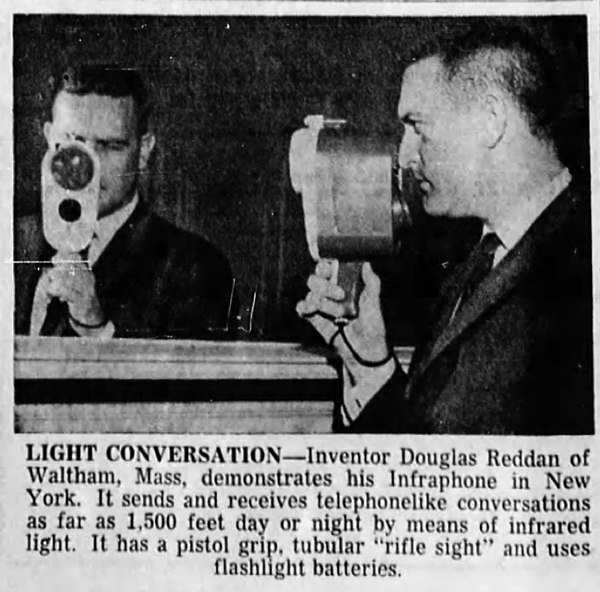
Eugene Guard - Nov 14, 1960
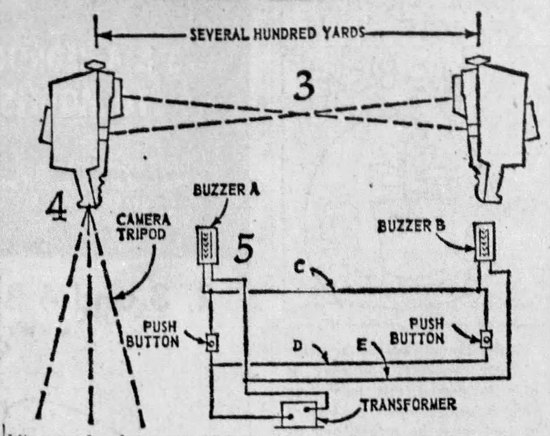
Palm Beach Post - June 4, 1961
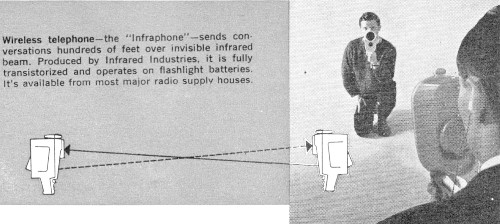
Popular electronics - Feb 1961 (via RF Cafe)
Posted By: Alex - Sat Aug 12, 2017 -
Comments (3)
Category: Inventions, Telephones, 1960s
Pumpndo
It allows you to pump and do! You could even pump gas while you pump milk.From MichiganRadio.org:
"I've driven while I'm using it. I've typed on the computer. I've chopped vegetables. You know, you can pretty much do anything," she said.
Posted By: Alex - Tue Aug 01, 2017 -
Comments (3)
Category: Inventions
Self-Propelled Aquaplane
It looks like the guy is about to send the girl flying into the air, but apparently he was demonstrating some kind of water rescue device, not a rocket.
"S. Shapiro, inventor, strapping his Shapson aquaplane on Miss Margaret Travis for demonstration at Santa Monica, Cal. The model is 44 inches over all and is operated by cranks which the swimmer turns to propel the plane. A speed of 12 knots can be obtained." — Chicago Tribune - Mar 3, 1935

East Liverpool Evening Review - Mar 1, 1935
Posted By: Alex - Mon Jul 24, 2017 -
Comments (5)
Category: Inventions, 1930s

| Who We Are |
|---|
| Alex Boese Alex is the creator and curator of the Museum of Hoaxes. He's also the author of various weird, non-fiction, science-themed books such as Elephants on Acid and Psychedelic Apes. Paul Di Filippo Paul has been paid to put weird ideas into fictional form for over thirty years, in his career as a noted science fiction writer. He has recently begun blogging on many curious topics with three fellow writers at The Inferior 4+1. Contact Us |




